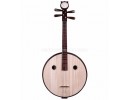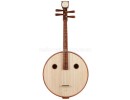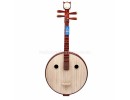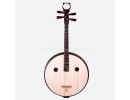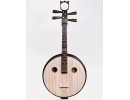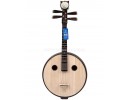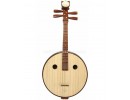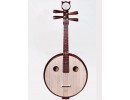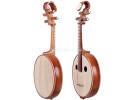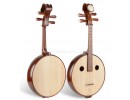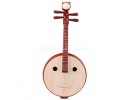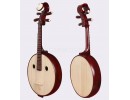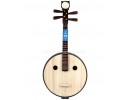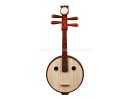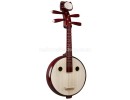Ruan
The Ruan is a very ancient four-stringed moon-shaped lute with a long and straight neck and various number of frets. Ruan used to be called "p'i-p'a" (pipa) or qin-pipa. Mellow in tone quality, it is often seen in ensembles or in accompaniments, and also as a solo instrument.
It is a short necked Chinese foiled lute with four strings, played by plectrum. It is used by orchestras as well as for accompanying operatic performances. The Ruan consists of three parts: resonator, neck and head. On the neck are 24 frets in half steps. Four strings, tuned to fifths (like a mandolin), provide a wide range of notes.
It comes in several sizes according to their different ranges constructed as a family of soprano, alto, tenor and bass. The alto (Xiao Ruan) and the tenor (Zhong Ruan) are commonly used. A plectrum or pick is needed in performance. Mellow in tone quality, it is often seen in ensembles or in accompaniments, and as a solo instrument in recent years. The Ruan has a beautiful mellow tone that is very similar to that of the guitar. The Ruan is mostly used for Peking opera, and now also in modern Chinese orchestra. Common tunings are GDAE or ADAD for the Ruan and BFCG, CGDA, or CGCG for the Da Ruan.
The Ruan was once termed as Qin pipa (dating to the Qin dynasty between 221-207BC) or Yueqin (moon shaped short neck lute). Since the introduction of the oud-like lute through the "silk-road" in the early Tang Dynasty (around 5th century), the Pipa gradually developed into the present form, and the old form of Pipa with straight-neck and round body got the name "Ruan", after the name of the master player of this instrument. That player, Ruan Xian, was one of the seven great scholars known as "The Seven Gentlemen in the Bamboo Forest" in Chinese history of the 3rd century (the Six Dynasties).
Among the artifacts unearthed in the Six Dynasties (220-581) Tomb at Xishan Bridge, Nanjing, there was an engraved picture showing Ruan Xian, playing a musical instrument. During the Sui and Tang dynasties (581-907), the Ruan was generally used for playing court music and folk dance music. There are many 7th Century depictions of the ruan in court orchestras painted on the walls of caves in DunHuang. In ancient times the Ruan had 8 frets; nowadays it is equipped with 4 strings and 24 frets.

